The Golden Pipeline
Living and working in Perth on the West coast of Australia, we had finally saved up enough money to get my motorbike shipped over from the East coast, where our good friend Elizabeth had been looking after it for over a year while we were off travelling. We were looking forward to using it to explore the remoter areas of our new home state.
The XJR’s arrival on the road train transporter exactly coincided with a lucrative job offer back on the East coast. We couldn’t bear the prospect of paying the road train to immediately take the bike back again, so we decided to ride East instead. Unfortunately there wasn’t enough time to get all the way to Brisbane before the start of our new contract, but we reckoned that in two weeks we could easily cross the famous Nullarbor Plain and get as far as Adelaide. We would then catch a plane for the short hop to Brisbane and ship the bike once again; prices from Adelaide to Brisbane are much lower than from Perth, because of the vast distances involved in crossing the Nullarbor.
We had intended to hit the road at lunchtime, but what with one thing and another (moving out of our Perth flat, cleaning it for the agent, shifting all our gear into storage, taking the removal van back to the hire shop) we didn’t get started until past three o’clock. Clearly it was going to be dark when we arrived at our first stop in the gold town of Kalgoorlie.
Loaded with camping gear and extra jerry cans of fuel and water, we began to make good time. Elizabeth had very kindly had the bike tuned before loading it onto the transporter in Sydney, and it was running very sweetly indeed. Although it had been years since our last motorcycle road trip, we quickly fell back into the old routine. With effectively only a single highway leading from Perth to Adelaide, we were in no danger of getting lost, but we did have to carefully plan our fuel stops. The big thirsty 1300cc engine sucked a lot of fuel, and so we could only go about 200 km on a tank, which broke the journey naturally into two-hour segments.
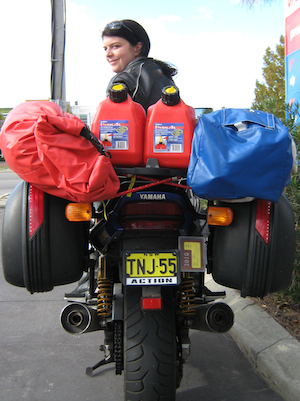
The Great Eastern Highway clambers up out of Perth and over the Darling Ranges before heading straight as an arrow across the Eastern Gold Fields to Kalgoorlie. Fuel was not a great problem on this first leg, with regular stops servicing road trains and commuting mine staff. Each petrol station doubled as a diner with varying degrees of home-cooked food. One might be a fish and chip shop, the next a traditional truckers diner, but the food was always good and the stops busy.
Once out of the Ranges, the terrain was completely flat, light woods giving way to unrelieved acres of grassland. The road was accompanied by two other man-made structures, the railway and the water pipeline. The Goldfields Pipeline is one of the engineering wonders of WA, running above ground for 530 kilometres and supplying precious water to Kalgoorlie and Boulder in the dry red interior. In the 1890s people in the burgeoning gold towns were dying from lack of water, and engineer C.Y. O’Connor spearheaded a campaign to build a pipeline from the coast. It was the longest pipeline project in the world, and needed a system of steam-driven pumping stations to force the water up over the intervening Darling Ranges. Although supported by the WA government, there was fierce opposition to what was regarded as an unfeasible waste of money. There is a story that on the the first test of the newly completed system, the engineer opened the taps, and… nothing happened. Mr O’Connor, exhausted from the stress, put a gun to his head and killed himself. The following day, the water completed its long journey and emerged from the pipe, and has been flowing ever since.
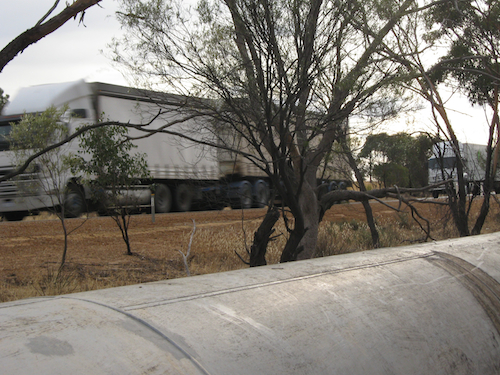
Most of the traffic in these parts consists of road trains, limited in length to 35 metres and 100 km/h and so are relatively easy to pass on the straight road, unless they are wide loads carrying mining machinery, in which case they take up most of the available space in both directions. These extra-large transporters are accompanied by groups of pilot vehicles which go ahead to warn oncoming traffic, and run interference from behind to prevent you from overtaking until the whole flotilla is ready.
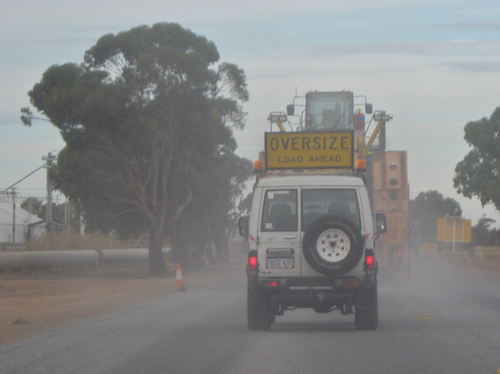
There was a popular belief in Perth when we left that kangaroos were a big problem on this road at dusk, but we didn’t see a single road-kill corpse, so we took that with a large pinch of salt. We have lived in the Australian Capital Territory where the roadside can be lined with dead roos and wombats, and the stench of rotting bodies on a hot day can make you gag. The only living creature on this segment of the Great Eastern Highway was the occasional crow picking squashed bugs off the road.
As darkness fell, we ran into a swarm of bogon moths, big fat migratory insects that are regarded as a delicacy by some aboriginals. Caught in the headlights at 140 km/h, it is like heading into a swarm of soft bullets, swiftly covering your helmet visor in an impenetrable layer of sticky bug juice.
Kalgoorlie
The day before we arrived, an earthquake hit the Kalgoorlie-Boulder metropolitan area, destroying much of Boulder’s historical centre, so we were a little unsure what we would find in its twin borough of Kalgoorlie. However the town seemed unscathed and business was continuing as usual and we checked into the Youth Hostel without any problems.
Most of the cheap accommodation is to be found opposite the town’s three brothels, some of which are museums by day while plying their more traditional trade after nightfall.
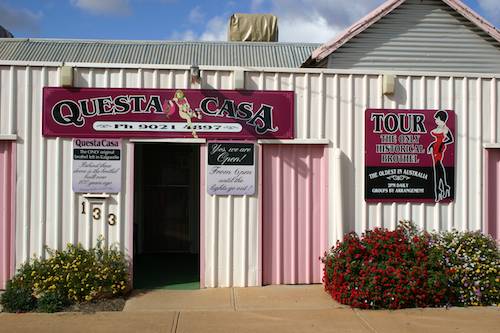
From there it was but a short step to the Exchange Hotel, where negligee-glad “skimpies” served us very welcome pints of frosty beverage. The skimpies are a bit of an institution in Kalgoorlie, pretty girls shipped in from outside to pull pints wearing nothing more than a continually changing set of underwear, to the appreciation of the almost exclusively male mining population. For a while there was a bit of an arms race between the pubs, until all the wait staff were going topless, but since then it has apparently settled down a bit. The girls themselves are happy and congenial, although often not enormously competent at bar work. If you want something other than a pint of cold, it is often best to approach one of the regular, more conventionally clad bar staff.
There is a lovely but little-known balcony upstairs at the Exchange, which looks out on the whole town of Kalgoorlie, and from which you can watch the parade of punters milling around the other pubs in the centre.
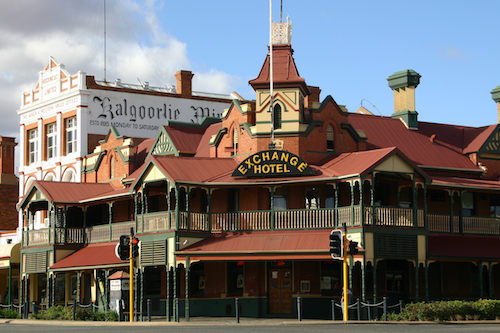
Everybody in Kalgoorlie is small-town friendly, and we soon ended up drinking with a mixed crowd of wiry mine engineers, Maori bouncers, and Aboriginal ne’er do wells. The night degraded appropriately into the usual debauchery; the Aboriginals started fighting each other and were ejected, and the skimpies knocked off work and joined us in the Palace Hotel across the road. Somewhere in the melee, Bronwyn’s handbag disappeared, but our kindly new friends made sure that we were alright for beers.
Back at the hostel we realised that the code for the combination lock at the entrance was stamped on the fob of our room key, which was in Bronwyn’s bag. I wandered around the outside of the building and eventually located a loose window which I managed to jemmy open so at least we were able to get inside, but no amount of fossicking with my library card was going to get us through the impressive lock into our room. Luckily there were some sofas scattered about in the corridor, so we passed out on those instead.
The morning brought a spare key and rain. We had breakfast at the excellent Kaoss Cafe in the central St Barbara Square, where the chef prepares all those out-of-style English dishes that you had forgotten about: bubble and squeak, liver and onions, mince on toast, and a host of others.
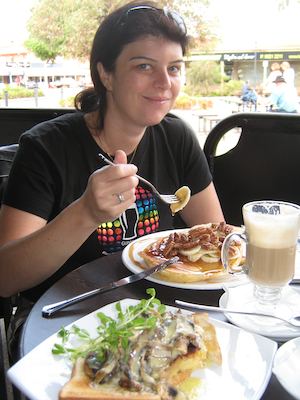
We strolled gently around town, interspersed with coffee and cake in an attempt to clear the mental fug. The rock museum at the Western Australian School of Mines is exactly what a museum should be. No shiny plastic and multimedia presentations here. The cabinets are scarred wood and glass and a little dusty, the exhibits labelled by hand on cardboard squares containing either a detailed technical explanation, a single terse word, or nothing at all, depending on the whim of the curator at the time.
The collection houses a representative sample of every rock, mineral and gemstone found in the Eastern Goldfields, with special prominence given to the different forms of ore that are so crucial to the wealth of Western Australia. This is not a museum for idle onlookers, this is a serious tool for the fledgling geologist. Pride of place, of course, goes to the models of the biggest gold nuggets found in the early days of the gold rush, some a foot or so across and containing a thousand or more ounces of gold and silver.
Tossing up whether to stay another night or ride off in the rain, we eventually paid a last visit to the Exchange Hotel to see whether they’d found Bronwyns hand bag (they hadn’t), mounted the bike and headed east.
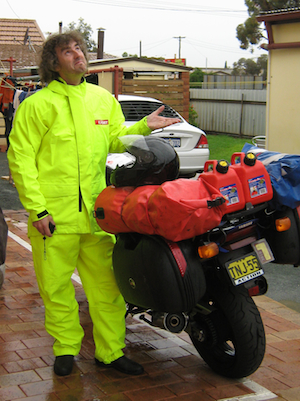
Kalgoorlie Super-Pit
On the way out of town is the Kalgoorlie Superpit, another of those technological marvels that are scattered around a state used to doing things big. Historically, gold here was mined by individual lease-holders digging shafts with little more than dynamite and a shovel, and in the early twentieth century the landscape was littered with derricks and processing sheds. Eventually there came a point where it was uneconomic for a man and a spade to dig any deeper, and entrepreneur and con-man Alan Bond came up with a plan to buy up every single mining lease and then dig an enormous pit to extract every last ounce of gold.
Bond’s business failed, but the block of mining leases was taken up by another company, KCGM, who went ahead and dug the biggest gold mine in the world. The pit is truly enormous, and aircraft landing at Kalgoorlie-Boulder Airfield now have to detour around it because it creates a huge hole in the atmosphere above. We had originally bought tickets for a tour of the mine, but this had been cancelled because of the earthquake, and we had been told that even the public viewing gallery on the top of the spoil heaps had been closed for safety reasons.
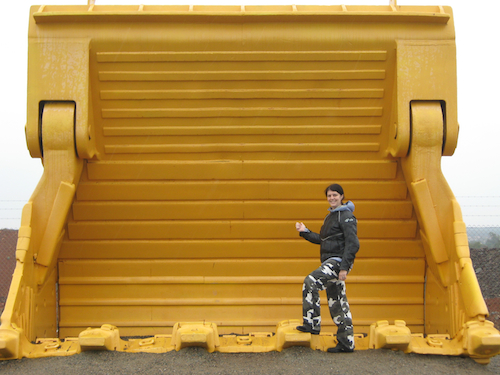
As we rolled past in a light drizzle we noticed that the gate was now open, so we rode up the hill and took a look. The mine, usually buzzing with enormous machines crawling in the stupendous space like ants, was eerily quiet, so presumably they were still running tests; we’d heard that they were going to dynamite some possibly unsafe areas that afternoon, so maybe that’s why most of the machinery had been removed. Despite the quiet, it was still a really impressive hole in the ground. Here and there up the pit wall were tiny caverns, representing the tunnels dug by the original miners, now exposed as the superpit expands downwards and outwards.
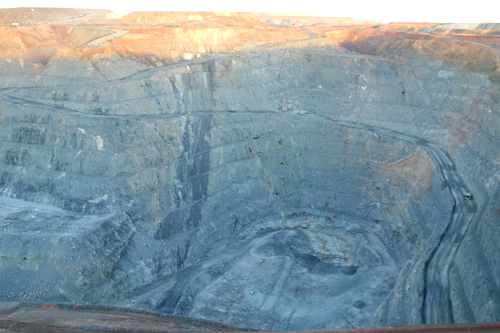
Back on the Goldfields Highway, it was only 300 km to Norseman, gateway to the Nullarbor. We stopped about half way in the mining village of Kambalda, partially to refuel but mainly to get some sugar as I was still having some trouble concentrating through my hangover. Next to the petrol station was the mining village itself, a community of tiny cabanas for the use of shift workers at the mine. The cabanas themselves were extremely small, with probably only space to sleep and bathe, but the site was pin-neat and equipped with a pool and a bar.
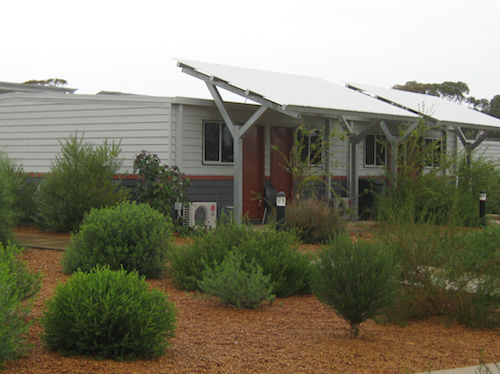
At about this time, I discovered that there was a message on my telephone, from Bronwyn’s mobile. The staff at the Exchange had found her hand bag, complete with wallet, phone and money, and had rung the most recently used number in an attempt to get hold of her. In fact the bag had not been stolen at all, but had been picked up by an overzealous bouncer while we were looking the other way. We turned around and headed back, picked up the hand bag and, reasoning that it was (a) late, (b) still raining and (c) we already had a room key, returned to the Youth Hostel for another night. The Nullarbor could wait one more day.